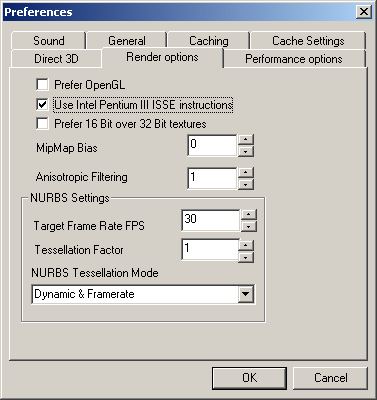
The Render Options changes global rendering preferences.

Prefer OpenGL:
If enabled, the Contact OpenGL driver is used on startup for 3D rendering.
Use Intel Pentium III ISSE instructions:
If enabled (default) Pentium III/IV ISSE operations are used for some Matrix and NURBS operations.
Prefer 16 bit over 32 Bit textures:
Direct X only, if enabled instead fitting image textures into 32-Bits, the textures are reduced to 16-Bits. This might improve performance on lower-end cards.
MIP-Mapping bias:
An offset for mip-mapping, -0.5 is recommended.
Anisotropic filtering:
If supported by the hardware and enabled in the Graphics Drivers Advanced Display Settings, the driver chooses texture MIP-Levels depending on Anisotropy. This normally gives a much better mip-map filtering quality.
NURBS settings:
Target frame rate FPS:
Prefered target frame rate.
Tessellation Factor:
Scaling factor for scene specified tesselation density.
NURBS Tessellation Mode:
How tesselation of NURBS surfaces is computed:
Dynamic & Framerate : tesselation is choosen automatic according to Target Frame
Static : tesselation depending on scene settings scaled by Tessellation Factor.
Dynamic:
Framerate: tesselation depending on frame rate
For more information refer to the "NURBS Project" overview.